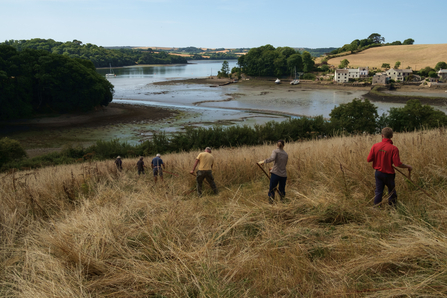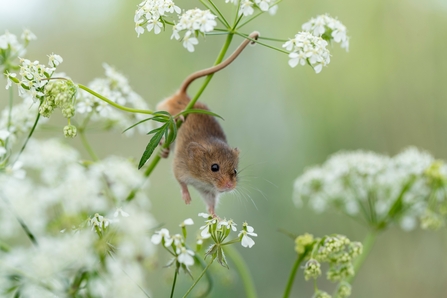Sometimes, even in Cornwall, we spend too much time inside buildings – quite possibly looking out through our windows at other people’s buildings. This year, the yearning to escape into the wide outdoors has been stronger than ever. One of the largest nature reserves managed by Cornwall Wildlife Trust offers much-needed space and tranquillity close to a built-up area.

Illustrated map of Churchtown Farm
A large nature reserve adjoining a town
Churchtown Farm Community Nature Reserve encompasses just over 150 acres (61 hectares) of land, much of it surrounded by water. It is accessed from roads within Saltash, a town which nestles in the far south-east of Cornwall, with the Devon city of Plymouth just across the Tamar. Yet the larger of Saltash’s nature reserves (there is also a wet meadow at Tincombe) feels like a world apart. When you visit the reserve, be sure to take photographs and bring binoculars if you have some, to make the most of glorious views out to the rivers Lynher and Tamar.
Time to look at the views
All of my visits to Churchtown Farm have left me with lasting memories of breath-taking vistas, taking in serene estuarine waters, and the green of distant countryside. Equipped with sturdy walking boots for some downhill and uphill trekking, it’s great to breathe the coastal air as you navigate a quilt of rolling hillside fields. From the reserve you see tantalising objects in the landscape – a turreted castle tower (Trematon Castle), the arches of a stone viaduct, or the remnants of a tide-lapped vessel resting at peace.
A yacht moored across the water, a few dog walkers, and the occasional diesel train, hurrying along the main line below the path from the Wearde Road entrance or above the sloping hayfields – provide a brief reminder that you haven’t slipped through a chink in the space-time continuum to the wildlife-rich days of yesteryear when time was measured in sunrises, sunsets and seasons.
Churchtown Farm Community Nature Reserve through the seasons
I have been to the reserve for an open day, guided walks, a scything work party and a family outing through the changing seasons.
On an April trip, our local Wildlife Group began our guided walk, hosted by East Cornwall Reserves Manager Peter Kent, standing in grassy Hitchings Field, where there’s a sturdy map of the area. Up there, a fresh spring breeze blew our cares away but after a hike downhill, we experienced calm moments in the sunshine watching still waters reflecting the sky. There was plenty of time to potter around by the water’s edge looking for wildlife signs.
We caught glimpses of rich plant, insect and bird life in the vibrant hedges – different from the short, flail-cropped, over-barbered versions of hedges you see around too many fields in east Cornwall.

Volunteers and Reserves staff scything at Churchtown Farm
On another visit back in August 2019, I remember admiring thousands of shiny blackberries ripening in the hedges. Now, in October, the last blackberries, drenched by recent rain, are complemented by a wealth of sloes on countless blackthorn bushes. The sloes are a beautiful deep blue-black, but I look forward to early spring, when the sloes will be over and the blackthorns begin a new season by icing the hedges with their white blossom.
When my son and I joined a scything party at the reserve on a glorious late summer day, we found we had excellent company in the volunteers who made up the Wild Allet crew and their friends. It felt good to scatter wildflower seeds on the earth as we swept our blades through buff-coloured stalks and stems, gradually working our way across a small meadow. We took turns to rake huge forkfuls of hay to the field edges, against a backdrop of lazy blue waters.
On that day, gazing outwards, the rest of human life consisted of little more than the occasional small cluster of waterside buildings across the estuary and its inlets. It also paid to look closely at the ground. Amongst the cut hay I found a nest that had belonged to a harvest mouse – our smallest (and some might argue, prettiest) mammal, sadly thought to have suffered steep declines as farming methods have changed. Looking upwards in summer, the wide skies are punctuated by swifts, swallows and skylarks.

A Harvest Mouse on Cow Parsley, Image by David Chapman
You never know which fungi will pop up on a nature reserve, and October is a very good time to look, especially if there’s a chance to join an official foray, where you can learn to identify the vast array of species in the various habitats, associated with different soil types and different trees. Although Churchtown Farm is primarily a farmland area, as its name suggests, there are also areas of wetland, woodland and scrub, two interesting old quarry sites and, at the lowest points, muddy banks and mudflats lining the estuary. Another advantage of autumn is that the evenings are earlier and on a clear day, you can capture the glory of a sunset over the water.
Winter is a good time to look for overwintering resident and migrant birds. On the mudflats, look out for oystercatchers, redshanks, greenshanks, and the pure white feathers of graceful egrets.
Seed crops such as sunflowers and teasels provide much-needed food for dwindling farmland bird species, including finches, linnets, buntings and bramblings over the winter.
Stretching my legs on a long autumn or winter walk around the reserve certainly puts me in the mood for tea and cake, followed by a good sleep, fuelled by the sea air.
Visiting the reserve
Usually, there are a variety of events to enjoy organised by the Friends of Churchtown Nature Reserve, a local community group who care about the nature reserve: organising walks, clean-ups and social events. The Friends also monitor the site. Their website includes a useful map including field names, tracks and boundaries, a lyrical and fact-filled report, a gallery of photographs, and documents including a detailed plant list. They also have a Facebook page that you can follow too.
You can find out more information about the Churchtown Farm reserve, along with visiting other Cornwall Wildlife Trust nature reserves, on the website through the links.








